Sensory Evaluation Of Food - FoodResearchLab
Sensory Evaluation is a scientific method to analyse and interpret the smell, sight, taste, touch response to a food product, and our trained experts will provide you with the analytical methods to perfect your product.
At the Food Research Lab, we conduct sensory analysis with accurate results to provide the best tasting product to our clients.
Reach us: https://www.foodresearchlab.com/what-we-do/sensory-evaluation/
Share Presentation
Embed Code
Link
Download Presentation

foodresearch + Follow
Download Presentation
Sensory Evaluation Of Food - FoodResearchLab
An Image/Link below is provided (as is) to download presentation Download Policy: Content on the Website is provided to you AS IS for your information and personal use and may not be sold / licensed / shared on other websites without getting consent from its author. Content is provided to you AS IS for your information and personal use only. Download presentation by click this link. While downloading, if for some reason you are not able to download a presentation, the publisher may have deleted the file from their server. During download, if you can't get a presentation, the file might be deleted by the publisher.
Presentation Transcript
- Sensory Evaluation of Food An Academic presentation by Dr. Nancy Agnes, Head, Technical Operations, FoodResearchLab Group: www.foodresearchlab.com Email: info@foodresearchlab.com
- TODAY'S DISCUSSION Introduction What Is Food Sensory Evaluation? Why is Sensory Evaluation In The Food Industry Important? Difference Tests Descriptive Tests Affective Testing Conclusion
- INTRODUCTION People make food choices based on various factors such as cost, preference, previous experience, and what is healthy. Still, probably more crucially, they employ information collected through their senses: look, texture, taste, and smell. These sensory elements can increase a food product's appeal, demonstrate attractiveness and quality, or meet the tastes and desires of critical groups. Food product sensory analysis can give manufacturers information for product development, marketing, and other claims.
- WHAT IS FOOD SENSORY EVALUATION? Sensory assessment is a scientific field covering all techniques for eliciting, measuring, analyzing, and interpreting human reactions to food characteristics perceived by the five senses: taste, smell, touch, sight, and hearing. Taste and smell are two senses that have piqued researchers' related to ingestive behaviour. curiosity, particularly
- WHY IS SENSORY EVALUATION IN THE FOOD INDUSTRY IMPORTANT? Sensory assessment is a necessary method in the following five categories of problems: Development of new products Cost-cutting measures Increasing the level of quality Product acceptability Contd.
- Quality assurance and control The sensory evaluation focuses on objective measurements of product sensory properties and subjective responses to physical products and interpretation of consumer response through product understanding. One can use sensory analysis for quality control, shelf-life determination, estimating product launch readiness, evaluating product success, flavour profiling, and finding the factors that drive customer preferences. You can use it to make critical decisions concerning raw materials, components, additives, storage and packing conditions, expiration or "best by" dates, and product optimization.
- DIFFERENCE TESTS Difference testing compares food items to see if they differ in any way. The odour, taste, and texture are only a few of these characteristics. The three different types of tests, the triangle test, the duo-trio test, and the paired comparison test, are: The discernible sensory differences exist between two items. Triangle Test determines whether Contd.
- It is especially effective when production adjustments may have resulted in product alterations. The panellists taste the three samples and identify which one is unique. When there is significant taste carryover across samples and panellists are puzzled by three models to evaluate rather than two, a triangle test may not be the best option. Contd.
- The Duo-Trio Test can also be used to detect product variances caused by changes in ingredient suppliers, storage, packaging, and other -factors. The sensory Eater indicates the sample that is identical to a specific reference sample. It is straightforward to comprehend. Paired Comparison Tests determine which of two samples has more of a given attribute or which of two examples is favoured. It is regarded as an acceptability test in the latter application. It's one of the most used attribute difference tests, and it's simple to grasp for panellists.
- DESCRIPTIVE TESTS A descriptive food sensory analysis provides a complete profile of a food product's sensory attributes and a qualitative assessment of the intensity of each feature. Flavour Profile Test Character traits, attribute intensity, order of aftertaste, and amplitude are the five primary components of the Flavor Profile approach (the overall impression of the analyzable and non- analyzable flavour components). attribute appearance, Contd.
- Initially, the flavour profile was graded on a five-point scale: not present, threshold, minor, moderate, and vigorous. Over time, the scale has evolved to include more points (initially seven, now 14) to accommodate more intensity differentiation. Texture Profile Test: The Texturometer - A New Instrument for Objective Texture Measurement presented five primary characteristics for evaluating food texture (hardness, cohesiveness, adhesiveness, viscosity, and elasticity) and three additional factors (brittleness, chewiness, and gumminess). The Spectrum Descriptive Analysis incorporates the Flavor and Texture Profile Methodologies' rigorous training and organization and a more extensive panel group (up to 15 individuals), a more refined scale (usually 150 points, subject to the product), and statistical methods to the descriptive data.
- Qualitative Tests: Individual assessments are conducted with a panel of ten to twelve persons who are asked to quantify product qualities using a six-inch line scale with half- inch intensity indicators. Free Choice Profiling In two fundamental ways, Free Choice Profiling differs from the previously mentioned methodologies. To begin with, each panel's participants are "untrained" customers. Contd.
- They are not chosen based on their ability or expertise in spotting tiny changes in product qualities, even if they are given instructions on the evaluation. Second, rather than an empirical rating, the participants primarily focus on offering "liking" or "acceptance" replies (among other qualifiers) as a way of measurement for each quality.
- AFFECTIVE TESTING The test method is clear and straightforward, so the panel of consumers will know how to reply. The Paired Preference Test is a method of determining the preferences of two people. A preference test can be undertaken once a significant difference between the two wines has been resolved. This helps decide which wine mix to use or which yeast fermentation method to utilize. Contd.
- Ranking Test: A preference ranking test may be completed if more than two samples are reviewed. A customer can usually rank three to five pieces in a reasonable amount of time. The consumer is asked to rate the samples in preference in this sensory evaluation technique, with "1" being the most desired. The Hedonic Test The hedonic scale can be used to determine the degree to which one or more things are acceptable. This is a categorical scale with an odd number of categories (five to nine), ranging from "dislike highly" to "like extremely." There is a neutral middle (neither like nor dislike). Based on their responses, customers rank the product on a scale.
- CONCLUSION Sensory assessment is currently neglected in the food and beverage business, but it can benefit a winery that uses the procedures effectively. Sensory evaluation can provide a foundation for judgments if controls implemented, panellists are carefully selected, practical training, appropriate sensory methods are used, and correct statistical interpretation. are adequately Food Research Lab has expert sensory panellists who help clients in identifying and selecting the optimized product.
- Food Research Lab is a Global Contract R&D Food, Beverages & Nutraceutical Lab providing solutions to Food, Beverages and Nutraceuticals (F, B&N) industries worldwide. We are one of the most renowned food sensory testing companies worldwide.
- Contact Us UNITED KINGDOM +44- 161 818 4656 INDIA +91 9566299022 EMAIL info@foodresearchlab.com

Sensory Evaluation
Sensory Evaluation. FCS 3120. Food Quality. Sensory attributes Nutritive content Food safety. Sensory Evaluation. Human senses to evaluate palatability “humans” as panelist or judges as measurement instrument Value depends on objectivity & precision of judgments. Types of panelists.
1.65k views • 20 slides
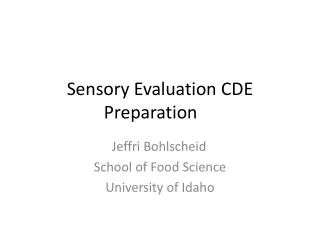
Sensory Evaluation CDE Preparation
Sensory Evaluation CDE Preparation . Jeffri Bohlscheid School of Food Science University of Idaho. Objectives . After this session the student will be able to Apply techniques of orthonasal evaluation of unknown aromas Apply multiple techniques to differentiate common food products.
949 views • 30 slides

Sensory Evaluation
DEFINITIONS:. A group of similar sensory impressions mediated by a given organ is referred to as sense (modality).Factors from the environment or from body biochemistry that elicit sensory impression are referred to as sensory stimuliA combination of sensory impressions is called a sensation.. D
1.49k views • 51 slides
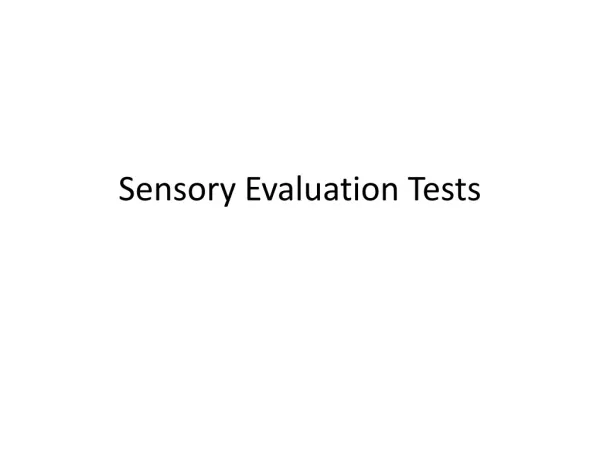
Sensory Evaluation Tests
Sensory Evaluation Tests. 1. Discriminatory Testing. Used to recognize or identify taste Used to training or select panelists for tasting. 2. Difference Testing. Identifies characteristics Determines if there is a difference between samples.
697 views • 12 slides
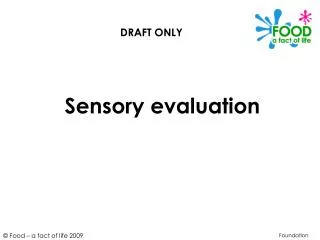
Sensory evaluation
DRAFT ONLY. Sensory evaluation. Foundation. Learning objectives. To know the purpose of sensory evaluation. To understand the difference between trained and untrained testors. To know which senses are used in sensory evaluation. To understand how sensory tests are used.
1.7k views • 20 slides
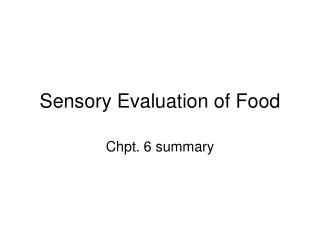
Sensory Evaluation of Food
Chpt. 6 summary. Sensory Evaluation of Food. Objectives/Terms. Describe sensory characteristics that affect food preferences
1.23k views • 17 slides
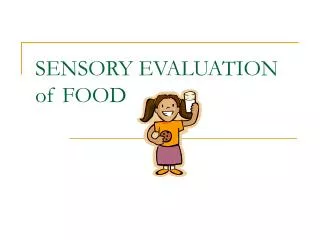
SENSORY EVALUATION of FOOD
SENSORY EVALUATION of FOOD. Why we eat?. Hunger Fuel our bodies Psychological ( emotional eating) Boredom. Nutrient--. “to nourish” Chemicals the body needs to function, grow, repair itself and creates energy. Basic Nutrients. Proteins Carbohydrates Fats Vitamins Minerals
1.01k views • 42 slides
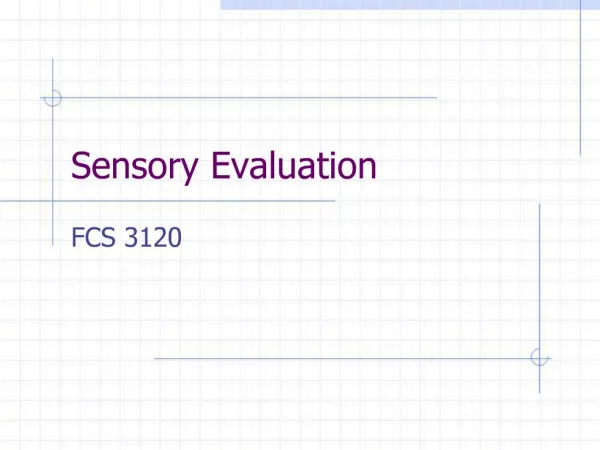
Sensory Evaluation
Food Quality. Sensory attributesNutritive contentFood safety. Sensory Evaluation. Human senses to evaluate palatability
491 views • 20 slides
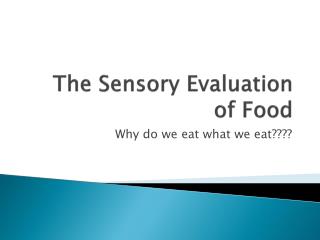
The Sensory Evaluation of Food
The Sensory Evaluation of Food. Why do we eat what we eat. Why do we eat what we eat.
218 views • 0 slides
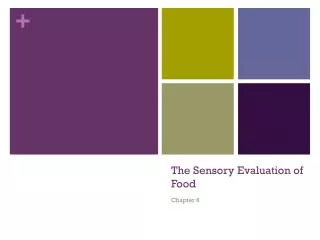
The Sensory Evaluation of Food
The Sensory Evaluation of Food. Chapter 6. The Sensory Evaluation of Food. Objectives . Vocabulary. Explain how various influences affect food choices. Describe sensory characteristics that affect food preferences. Plan a setting for successful sensory evaluation.
2.94k views • 10 slides

Sensory Evaluation
Sensory Evaluation. Chapter 6. Sensory evaluation panels. Groups of people who evaluate food samples. Three main groups – highly trained experts, laboratory panels, and consumer panels. Their input has a lot of impact on whether a food makes it from the test kitchen to the shopping cart.
422 views • 10 slides
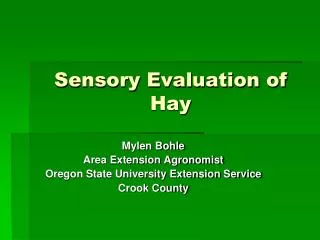
Sensory Evaluation of Hay
Sensory Evaluation of Hay. Mylen Bohle Area Extension Agronomist Oregon State University Extension Service Crook County. Hay Quality Sensory Evaluation Guidelines Acknowledgement (Utah State University Pub: AG/Forage & Pasture/2007-01). Authors Tom Griggs, Extension Forage Specialist,
455 views • 16 slides
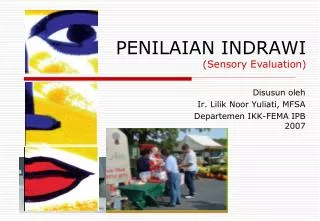
PENILAIAN INDRAWI (Sensory Evaluation)
PENILAIAN INDRAWI (Sensory Evaluation). Disusun oleh Ir. Lilik Noor Yuliati, MFSA Departemen IKK-FEMA IPB 2007. Looking Ahead. Setelah mengikuti kuliah ini, mahasiswa dapat :
325 views • 5 slides

التقييم الحسي ل لأغذية Sensory evaluation of Food
التقييم الحسي ل لأغذية Sensory evaluation of Food. المحاضر/ أ.د علي كامل الساعد رئيس الجمعية الأردنية للتقييم الحسي عضو الجمعية البريطانية للتقييم الحسي كلية الزراعة/الجامعة الأردنية ،عمان/الأردن email :akamil@ju.edu.jo. Introduction.
4.87k views • 366 slides

食品感官评定 Sensory Evaluation of Food
食品感官评定 Sensory Evaluation of Food. 教材及参考书目. 1 、张水华等 . 食品感官鉴定 . 广州 : 华南理工大学出版社 , 1999 2 、吴谋成 . 食品分析与感官评定 . 北京 : 中国农业出版社 , 2002 3 、李衡等 . 食品感官鉴定方法及实践 . 上海 : 上海科学技术文献出版社 , 1990 4 、 Harry T. Lawlass 等著,王栋等译 . 食品感官评价原理与技术 . 北京 : 中国轻工业出版社 , 2001. 食品感官评定是食品分析的一种。食品分析是为了满足消费者对食品以下几方面的需要:. 安全
1.15k views • 88 slides
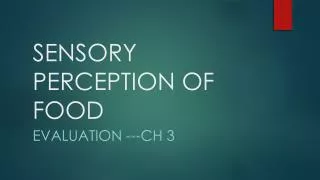
SENSORY PERCEPTION OF FOOD
SENSORY PERCEPTION OF FOOD. Evaluation --- Ch 3. Sensory evaluation. The sum of a food’s :. Influences on likes and dislikes. Physical (genetic differences) Psychological (taste bias created from past experiences) Cultural ( religion, region, lifestyle, beliefs) Environmental
667 views • 6 slides

Sensory Evaluation
Sensory Evaluation. Composition of Wine Week 2. Components of Wine. Water: 80 to 95% Alcohol Acids Polyphenols Sugars Carbon Dioxide/CO2. Components of Wine: Acids. Tartaric Acid: - the strongest acid -Specific to grapes, rarely found in nature
411 views • 22 slides

SENSORY EVALUATION OF FOOD
SENSORY EVALUATION OF FOOD. Influences on food choices. Emotions and Psychology comfort food and food associations. Culture and Geography such as this Greek cuisine. Beliefs Christmas cookies and Jewish Matzoh. Health Concerns i.e. low fat for heart health.
416 views • 10 slides

Sensory Evaluation of Food:
Sensory Evaluation of Food:. Influences on Food Choices and Sensory Characteristics. By: S. Klimek. Influences on Food Likes and Dislikes. Opinions about food are subjective - they are affected by personal views and backgrounds.
1.15k views • 28 slides

Food Sensory Analysis
https://www.lifeasible.com/custom-solutions/food-and-feed/food-testing/food-sensory-analysis/ Food sensory analysis is a scientific approach that is used to evoke, measure, analyze, and interpret human responses to food products. Senses which are perceived include sight, smell, touch, taste, and hearing, which are used to evaluated important food characters such as appearance, aroma, flavour, texture, sound, or others. Food sensory evaluation of products provides an understanding of the key sensory properties that drive consumer acceptability. It is becoming an important aspect of product quality control, new product development, as well as comparable market research.
169 views • 6 slides






















